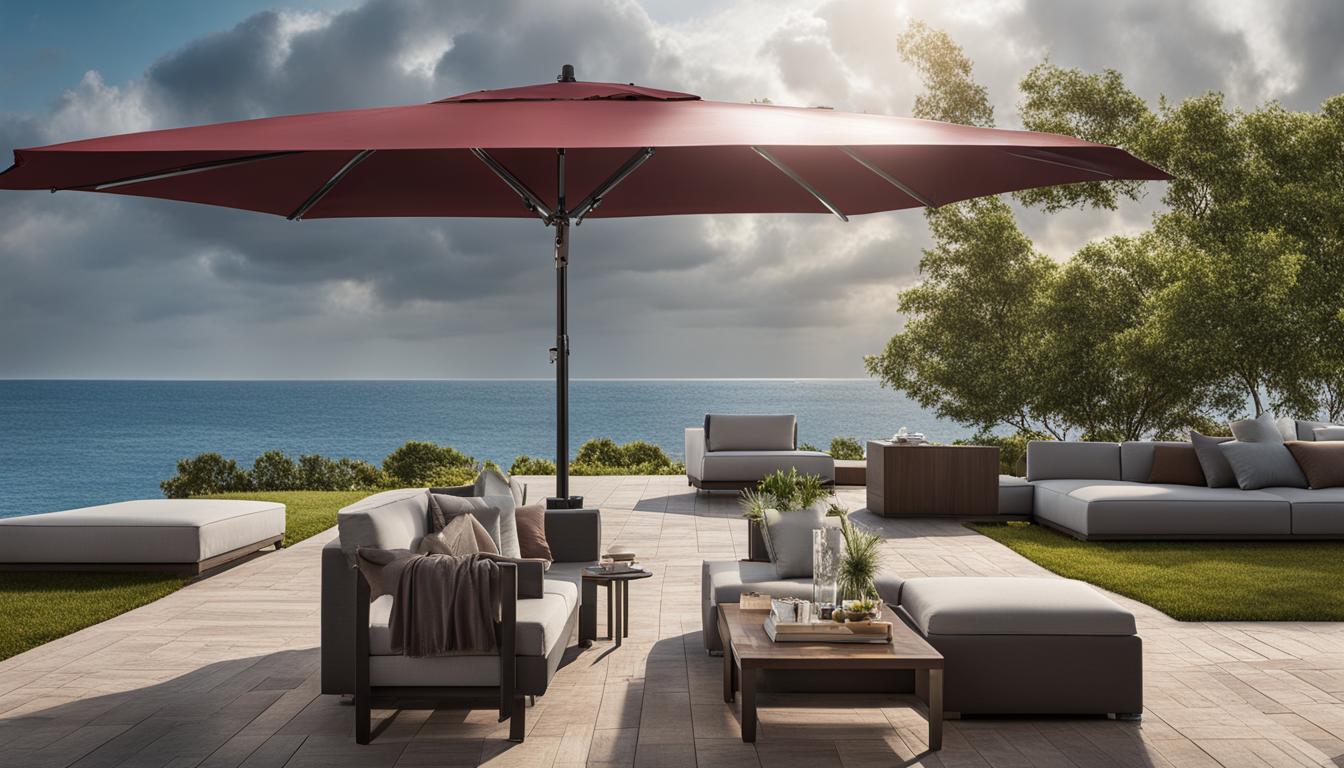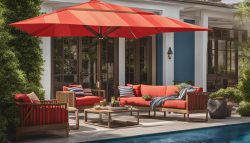Durability of Different Materials of Patio Umbrella in Various Climates

When selecting a patio umbrella for your outdoor space, it’s essential to consider its durability. Different materials of patio umbrellas perform differently in various weather conditions. Understanding the durability of each material will help you make an informed decision and ensure your investment lasts for years to come.
From aluminum to wood to fabric, each material has its own strengths and weaknesses. While some materials are lightweight and weather-resistant, others may require additional maintenance and protection to withstand challenging weather conditions.
Assessing the durability of patio umbrella materials in different climates will help you choose a long-lasting and stylish option that complements your outdoor space. Let’s explore the different materials of patio umbrellas and how they perform in various weather conditions.
Key Takeaways
- Different materials of patio umbrellas have varying levels of durability in different weather conditions.
- Understanding the durability of patio umbrella materials will help you choose a long-lasting investment for your outdoor space.
- From aluminum to fiberglass to wood, each material has its own strengths and weaknesses, and some may require additional maintenance and protection.
- Assessing the durability of patio umbrella materials in various climates will ensure your investment lasts for years to come.
- Consider the durability of not only the canopy but also the frame and base of your patio umbrella for long-lasting support in different weather conditions.
Understanding the Importance of Weather Durability in Outdoor Umbrella Materials
When purchasing an outdoor umbrella, one of the most crucial factors to consider is its ability to withstand various weather conditions. Choosing the right material for your patio umbrella can ensure longevity and prevent damage caused by harsh weather conditions, such as wind, rain, and sun exposure. By choosing durable outdoor umbrella materials, you can enjoy your outdoor space year-round without worrying about constant repairs or replacements.
The Impact of Weather Conditions on Outdoor Umbrella Materials
Weather conditions play a significant role in the durability of outdoor umbrella materials. For example, materials used in areas with high humidity or frequent rain may require more weather-resistant constructions. Conversely, materials used in areas with high winds may require additional support to prevent damage from strong gusts.
The Importance of Durability in Patio Umbrellas
Durability is essential when selecting outdoor umbrella materials. Well-made patio umbrellas can last for years, providing long-lasting shade and protection from the elements. However, poorly made umbrellas can degrade quickly and fail catastrophically, potentially causing injury or damage to your property.
When selecting outdoor umbrella materials, consider the following factors:
- The material’s ability to resist water damage, such as rotting or warping
- The material’s ability to resist UV damage, such as fading or cracking
- The material’s strength and resistance to wind stress
- The material’s weight and stability
Popular Outdoor Umbrella Materials
There are various outdoor umbrella materials to choose from, each with its unique properties and performance in different weather conditions. The most popular outdoor umbrella materials include:
| Material | Strengths | Weaknesses |
|---|---|---|
| Aluminum | Durable and lightweight, resistant to rust and corrosion | May dent or scratch easily |
| Fiberglass | Strong and resilient, resists breaking and bending in high winds | Can be heavy and expensive |
| Wood | Attractive and timeless, can be stained or painted to match outdoor decor | Requires additional maintenance and protective coatings to prevent weather damage |
| Fabric | Allows for versatile colors and designs, lightweight and easy to clean | May fade or tear over time, requires additional weatherproofing |
| Cantilever | Provides flexible shade options, durable and weather-resistant materials | May require additional installation and support, may be affected by strong winds |
Choosing the right material for your patio umbrella can make all the difference in ensuring its longevity and your enjoyment of your outdoor space. Consider the weather conditions in your area and the material’s durability when making your selection.
Assessing the Durability of Different Patio Umbrella Materials
When choosing a patio umbrella, it’s essential to consider the durability of the materials used. Different materials have varying degrees of weather resistance and longevity. In this section, we’ll explore the strengths and weaknesses of popular patio umbrella materials in outdoor parasols and how they fare in different weather conditions.
Acrylic
Acrylic is a popular material used in patio umbrellas due to its ability to resist fading and mold. It’s also water-resistant, making it ideal for use in areas with a lot of rainfall. However, acrylic may not be the most durable option for areas with high winds or extreme temperatures.
Polyester
Polyester is a budget-friendly material used in many patio umbrellas. It’s lightweight and easy to clean, but it may not be as weather-resistant as other materials. Polyester patio umbrellas are prone to fading and tearing, especially in areas with a lot of rainfall or strong winds.
Olefin
Olefin is a synthetic fiber used in many outdoor parasols due to its durability and weather resistance. It’s resistant to fading, mildew, and moisture, making it an ideal choice for areas with high humidity or rainfall. However, olefin may not be the best choice for areas with extreme temperatures as it can become brittle in very cold weather.
Sunbrella
Sunbrella fabric is a popular choice for patio umbrellas due to its durability and ability to resist fading, mildew, and stains. It’s also water-repellent, making it ideal for use in rainy areas. Sunbrella fabric is more expensive than other materials, but it can last for many years in various weather conditions.
Table: Durability of Patio Umbrella Materials in Different Weather Conditions
| Material | Strengths | Weaknesses |
|---|---|---|
| Acrylic | Resistant to fading and mold, water-resistant | Not as durable in high winds or extreme temperatures |
| Polyester | Budget-friendly, lightweight, easy to clean | Prone to fading and tearing, not as weather-resistant |
| Olefin | Durable, weather-resistant, resistant to fading, mildew, and moisture | Can become brittle in very cold weather |
| Sunbrella | Durable, resistant to fading, mildew, and stains, water-repellent | More expensive than other materials |
When choosing a patio umbrella material, consider the weather conditions in your area and the level of durability you need. By selecting the right material, you can ensure your patio umbrella will last for many years, providing you with shade and protection from the elements.
Aluminum: A Durable and Lightweight Option for Patio Umbrellas
When it comes to selecting a patio umbrella, durability and weather resistance are crucial factors to consider. One material that offers both is aluminum.
Aluminum patio umbrellas are durable and long-lasting, thanks to their resilience against various weather conditions. Unlike other materials, aluminum does not rust or corrode, making it a low-maintenance option for your outdoor space.
In addition to its durability, aluminum is also lightweight, making it easy to move and adjust the umbrella as needed. This feature is particularly important if you plan to move your patio umbrella frequently or want to adjust its position throughout the day as the sun moves.
Comparison of Aluminum with Other Materials
| Material | Durability | Weight | Weather Resistance |
|---|---|---|---|
| Aluminum | High | Lightweight | Resistant to rust and corrosion |
| Wood | Moderate | Heavy | Susceptible to rot and warping |
| Fiberglass | High | Moderate | Resistant to wind and rain |
| Fabric | Moderate | Lightweight | May fade or tear over time |
As the comparison table shows, aluminum is a standout material for patio umbrellas, with high durability, weather resistance, and lightweight characteristics.
When selecting an aluminum patio umbrella, it’s essential to choose one with a sturdy frame that will support the canopy in strong winds. Additionally, it’s crucial to maintain the cleanliness of the umbrella to prevent dirt and debris from building up and causing damage.
Overall, an aluminum patio umbrella is an excellent choice for those seeking a durable and long-lasting outdoor shade option.
Sturdy and Resilient: The Durability of Fiberglass Patio Umbrellas
Fiberglass patio umbrellas are a popular choice due to their durability. As a weather-resistant material, fiberglass can withstand harsh weather conditions, making it a long-lasting option for outdoor shade. Unlike other materials, fiberglass is flexible, which allows it to bend and return to its original shape without damage. This flexibility also makes fiberglass patio umbrellas resistant to breakage, making them ideal for areas with high wind gusts.
Did You Know? Fiberglass is a material made of reinforced plastic that consists of glass fibers embedded in a resin matrix.
When it comes to durability, fiberglass outperforms other materials, such as wood or aluminum. Unlike wood, fiberglass patio umbrellas do not crack or splinter, which means less maintenance and no need for protective coatings. Unlike aluminum, fiberglass is not prone to denting or corrosion, which ensures your umbrella will maintain its sleek appearance for years to come.
If you are looking for a durable patio umbrella that can withstand tough weather conditions, fiberglass is an excellent choice. Its resilience makes it ideal for outdoor shade options, including market umbrellas, cantilever umbrellas, and more. Moreover, fiberglass offers a wide variety of design options, so you can choose from various colors and patterns to match your outdoor space’s aesthetic.
Wood: A Timeless Material with Weather Durability Challenges
If you are looking for a classic and elegant option for your patio umbrella, wood is a popular choice. It offers a timeless aesthetic that complements any outdoor space. However, wood comes with some weather durability challenges that you need to consider to ensure its longevity in different climates.
The durability of wood depends on the type of wood used, the maintenance, and the weather conditions it is exposed to. Hardwoods like teak, cedar, and redwood are popular choices for patio umbrellas due to their natural resistance to decay and rot, as well as their durability. However, hardwoods can be expensive, and you need to maintain them regularly to ensure their longevity.
Note: Ensure you regularly clean your wood patio umbrella and apply a protective finish to prevent moisture from getting trapped in the wood, leading to decay and rot. Avoid exposing your wood patio umbrella to extreme weather conditions like heavy rain or wind, as this can cause the wood to swell and warp over time.
Softwoods like pine and spruce are less expensive, but they require more maintenance to ensure their longevity. These woods are prone to decay and rot if not maintained well and are not ideal for areas with high humidity or rainfall.
Another consideration when it comes to wood patio umbrellas is the frame construction. You can choose from different frame materials like aluminum, which is lightweight and durable, or wood, which offers a cohesive look with the umbrella canopy. However, if you choose a wood frame, ensure it is treated to prevent rot and decay.
Comparing Wood to Other Patio Umbrella Materials
| Material | Strengths | Weaknesses |
|---|---|---|
| Aluminum | Lightweight and durable, weather-resistant | May not offer a cohesive look with wood outdoor furniture |
| Fiberglass | Sturdy and resilient, weather-resistant | May be more expensive than other materials |
| Acrylic | Resistant to fading and UV rays | May not be as durable as other materials |
Compared to other materials, wood has its strengths and weaknesses. While it offers a timeless aesthetic that complements any outdoor space, it requires more maintenance to ensure its longevity. It may also be prone to decay and rot if not maintained well, and it may not be as weather-resistant as materials like aluminum or fiberglass.
Ultimately, the choice of patio umbrella material depends on your personal preference, budget, and the weather conditions in your area. Ensure you consider all the factors before making a decision to ensure you choose a patio umbrella that lasts for years to come.
Fabric Options: Assessing Longevity in Patio Umbrella Materials
When it comes to patio umbrellas, the fabric material used can significantly impact its durability and longevity. Choosing the right fabric can ensure your outdoor parasol withstands various weather conditions, making it a worthwhile investment for your outdoor space.
One of the most common fabric materials used in patio umbrellas is solution-dyed polyester. It is lightweight, easy to clean, and resistant to fading, making it a popular choice for outdoor parasol materials. Another option is olefin, a synthetic fiber with excellent weather resistance and fade-resistant properties.
If you prefer a more natural material, Sunbrella fabric is a durable and long-lasting option. Made of acrylic yarn, it is UV-resistant and water-repellent, making it ideal for outdoor use in various weather conditions.
When choosing a fabric material for your patio umbrella, consider the environment it will be in. For instance, if your outdoor space is exposed to strong winds, consider a heavier fabric material like acrylic or vinyl-coated polyester. Additionally, choosing a fabric with a tight weave can prevent dirt and debris from accumulating and causing damage.
Comparing Fabric Options for Patio Umbrellas
| Material | Pros | Cons |
|---|---|---|
| Solution-dyed Polyester | Lightweight, easy to clean, fade-resistant | May not be as durable in extreme weather conditions |
| Olefin | Weather-resistant, fade-resistant | May not be as soft as other materials |
| Sunbrella Fabric | UV-resistant, water-repellent, long-lasting | May be more expensive than other options |
A durable and weather-resistant fabric material is crucial in ensuring longevity for your patio umbrella. Consider the environment it will be in and the weather conditions it may face. With the right fabric material, your patio umbrella can provide long-lasting shade and style for years to come.
Evaluating the Durability of Cantilever Umbrella Materials
When it comes to outdoor shade options, cantilever umbrellas are a popular choice due to their versatility and convenience. But, as with any patio umbrella, it’s essential to consider the durability of the materials used to ensure they can withstand different weather conditions and provide long-lasting outdoor shade. Let’s take a closer look at the durability of cantilever umbrella materials, including their weather resistance and outdoor shade options.
Cantilever Umbrella Materials
Cantilever umbrellas are often made from aluminum or steel frames and are accompanied by fabric canopies. The durability of these materials is crucial to ensure that the entire structure withstands various weather conditions.
Durability of Cantilever Umbrellas
Cantilever umbrellas are designed to be sturdy and resilient, making them a long-lasting option for outdoor shade. However, when selecting cantilever umbrella materials, it is essential to consider weather resistance to ensure they can withstand different weather conditions.
Aluminum frames are lightweight and durable, making them a popular choice for cantilever umbrellas. They can withstand high winds, resist rust and corrosion, and require minimal maintenance. Steel frames, on the other hand, are more robust and can withstand more extreme weather conditions. However, they require more maintenance to prevent rust and corrosion.
The canopy fabric also affects the durability of the cantilever umbrella. Opt for weather-resistant and UV-protected materials that can withstand strong winds, harsh sunlight, and heavy rain. Some popular canopy materials for cantilever umbrellas include polyester, acrylic, and olefin.
Outdoor Shade Options
Cantilever umbrellas provide a versatile outdoor shade option, with many models offering adjustable heights, tilt, and rotation angles. Some models also come with LED lights or heating lamps for added comfort on chilly evenings.
When choosing a cantilever umbrella, consider the size and shape of your outdoor space, the amount of shade you require, and the overall design aesthetic. Some models offer rectangular canopies that provide more shade coverage, while others offer round canopies that provide a more traditional look.
Overall, cantilever umbrellas are a durable and versatile outdoor shade option when you select materials suitable for the local weather. Whether you opt for an aluminum or steel frame, ensure that the canopy fabric is weather-resistant and UV-protected to ensure long-lasting outdoor shade.
Considerations for Durability in Patio Umbrella Bases and Frames
When it comes to patio umbrellas, the bases and frames are just as critical as the fabric and canopy. The durability of the base and frame ensures that your umbrella remains stable and secure, even in adverse weather conditions. Selecting the right materials for your base and frame is crucial to ensure long-lasting support for your patio umbrella.
Materials for Patio Umbrella Bases
Choosing the right material for the base of your patio umbrella is vital. Here are some of the most common materials used:
| Material | Pros | Cons |
|---|---|---|
| Concrete | Sturdy and durable | Heavy and difficult to move |
| Plastic | Lightweight and easy to move | May crack or break over time |
| Steel | Durable and long-lasting | Prone to rust if not treated properly |
| Stone | Sturdy and decorative | Heavy and difficult to move |
Regardless of the material, make sure the base of your patio umbrella is heavy enough to provide adequate support and stability in windy conditions. As a general rule, the base should weigh at least 50 pounds for umbrellas up to 10 feet in diameter, and up to 100 pounds for larger umbrellas.
Materials for Patio Umbrella Frames
When it comes to the frame of your patio umbrella, there are two primary materials to choose from:
- Aluminum: Lightweight, rust-resistant, and durable, aluminum frames are a popular choice for patio umbrellas.
- Wood: Wood frames offer a classic, timeless look, but they require more maintenance than aluminum frames and may not withstand harsh weather conditions as well.
Generally, aluminum frames are the better choice for outdoor umbrellas due to their lightweight nature and rust-resistant properties. Additionally, aluminum frames offer excellent durability and resistance to various weather conditions, making them a long-lasting option for your outdoor space.
When selecting a patio umbrella frame, look for one with reinforced joints to ensure maximum strength and stability. The number of ribs in the canopy also affects the strength and wind resistance of the umbrella, so opt for a model with at least six to eight ribs for optimal durability.
Overall, choosing durable materials for your patio umbrella base and frame is essential for ensuring long-lasting support and stability. By considering the materials and their weather resistance, you can select a patio umbrella that will stand the test of time and provide reliable protection for your outdoor space.
Additional Factors to Enhance the Durability of Patio Umbrellas
Investing in a durable patio umbrella is a wise choice to ensure the longevity of your outdoor shade option. But, there are additional factors that can enhance the durability of patio umbrellas in various weather conditions:
Regular Maintenance
To keep your patio umbrella in top-notch condition, regular cleaning and maintenance are essential. Use a soft brush or cloth to remove any debris and dirt from the fabric and frame. Regularly check for any damages that may require repair.
Protective Covers
Protective covers are an excellent investment to keep your patio umbrella sheltered from harsh weather conditions when not in use. Choose a cover made of weather-resistant material to prevent moisture from seeping in and causing damage.
Proper Storage
If you live in an area with extreme weather conditions, it’s best to store your patio umbrella indoors during harsh weather seasons. Proper storage in a dry and safe environment can increase the longevity of your patio umbrella.
Consider Umbrella Bases
Umbrella bases play a crucial role in providing long-lasting support to your patio umbrella. Consider the weight and material of the umbrella base to ensure it can withstand strong winds and harsh weather conditions.
Choose High-Quality Materials
The quality of the materials used in your patio umbrella directly affects its durability. Opt for outdoor parasol materials that are UV-resistant, water-resistant, and weather-resistant to ensure longevity in various weather conditions.
By considering these additional factors, you can enhance the durability of your patio umbrella and enjoy long-lasting shade for years to come.
Conclusion
Choosing a long-lasting and stylish patio shade option can be a daunting task, but with the right information, you can make an informed decision. Understanding the durability of different materials used in patio umbrellas and how they fare in various weather conditions is essential in ensuring you get a long-lasting option suitable for your outdoor space.
When looking for a patio umbrella, consider the durability of the materials and how they can withstand weather conditions in your area. Aluminum and fiberglass are excellent choices for weather-resistant and durable options. However, wood may require additional maintenance to protect it from different climates.
Assessing the longevity of fabric materials and considering the durability of cantilever umbrella materials are important factors when making a choice. Additionally, ensure that the patio umbrella bases and frames you choose can withstand different weather conditions and provide long-lasting support.
To enhance the durability of your patio umbrella, consider regular maintenance and protective covers. Investing in these additional factors can significantly extend the lifespan of your patio umbrella, providing you with a long-lasting patio shade option for your outdoor space.
When shopping for a patio umbrella, ensure that you select a long-lasting option suitable for your outdoor space. By considering the durability of outdoor parasol materials and their longevity, you can enjoy a stylish and long-lasting patio shade option for many years to come.
FAQ
What materials are commonly used in patio umbrellas?
Common materials used in patio umbrellas include aluminum, fiberglass, wood, and various fabric options.
How do different materials perform in various weather conditions?
Different materials have varying levels of weather durability. Aluminum and fiberglass are known for their ability to withstand harsh weather, while wood may require additional maintenance and protection. Fabric options can also vary in their ability to withstand different weather conditions.
Are aluminum patio umbrellas lightweight?
Yes, aluminum patio umbrellas are lightweight, making them easy to maneuver and transport.
What makes fiberglass patio umbrellas a durable choice?
Fiberglass patio umbrellas are known for their sturdiness and resilience. They can withstand harsh weather conditions and are a long-lasting option for outdoor spaces.
Do wood patio umbrellas require extra maintenance?
Yes, wood patio umbrellas may require additional maintenance and protection to ensure their longevity in different climates.
How can fabric options enhance the longevity of patio umbrellas?
Different fabric materials used in patio umbrellas can vary in their ability to withstand weather conditions. Choosing a high-quality and weather-resistant fabric can enhance the longevity of your patio umbrella.
What materials are commonly used in cantilever umbrellas?
Cantilever umbrellas can be made from various materials, including aluminum, fiberglass, and fabric options.
What factors should I consider for patio umbrella bases and frames?
When considering the durability of patio umbrella bases and frames, it is important to assess the materials used in their construction and their ability to withstand different weather conditions. Ensure they provide long-lasting support for your umbrella.
How can I enhance the durability of my patio umbrella?
Regular maintenance, such as cleaning and inspecting for any damages, can help enhance the durability of your patio umbrella. Using protective covers when not in use can also provide added protection against the elements.
- Crafting a Dream Patio with Pavers - November 26, 2023
- DIY Patio Paver Construction - November 24, 2023
- Creating Stunning Patios with Pavers - November 21, 2023


